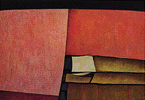No doubt
Gerzso's flight into the interior (interior Mexico, interior Gerzso) was
assisted by his friendship with an extraordinary poet, Benjamin Péret, with
whom he became friendly toward 1944. Péret's exceptional personality,
acknowledged by all who knew him, could not fail to have impressed the
sensitive painter. He had come to Mexico with a grand ambition: to write a
book on the myths, legends and popular fables of the Americas. The foreword
to that book, La Parole est à Péret, was endorsed by distinguished writers
and painters all over the world when it was published in 1943 (among them
André Breton, Aimé Cesaire, René Magritte, Wifredo Lam, Marcel Duchamp and
Max Ernst).
Péret wrote with tremendous conviction of the importance of the
native imagination, dipping back into history to quote Goethe: "man cannot
remain long in the conscious state and must plunge again and again into the
unconscious because the root of his being dwells there." Péret invoked New
Mexican kachina dolls and Mexican jade masks and insisted that "the
marvelous is everywhere, of all times and of each instant." His poetry, with
which Gerzso was intimately familiar, is, for all its Surrealist dislocations
and abrupt transitions, remarkably close in spirit to the images of Gerzso,
even those most akin to the tradition of KIee and Malevich
(and KIee, it must be remembered, was much admired in the first
Surrealist exhibition in 1925). Péret's poems written in Mexico are redolent
with the imagery of the place. The Swirl of Dust for instance begins: "When
stones slam their doors as a sign of despair" and finishes, "between
vines digesting centuries would fill with thundering Americas
hardly suspected in a comma." Even more startling, perhaps, is the prophetic
poem written in the 1930s with the compelling first stanza:
Here begins the glacial house
where the roundness of the earth is only a word
as light as a leaf
whose quality matters little
In the glacial mansion dances
all that the movement of the earth cannot prevent from dancing
all the beings whose existence is improbable
There time is the same as the partition of an empire
as the long march of Lilliputians
as the cataract 1800 meters high
(from Four Years After the Dog )
I dwell on the affinities between Péret and Gerzso because I believe that for
all the apparent formal language in the paintings, and for all the knowing
incorporation of the modern plastic idioms, Cubism, Constructivism, and
even Surrealism (if we think of the abstract branch consisting of Miró and
Gorky), Gerzso's paintings remain rooted in the Surre alist
philosophy in which surprise and wonder, and
dramatic heightening and
otherness, are worshipped. Above all, the unaccustomed collisions of images.
The important function of juxtaposition in the Surrealist theory is served
admirably in Gerzso's paintings, as it is in Péret's poems. There are, for
instance, enormous vistas in the work of both, and these vistas, seen from
afar, have a millennial silence that, in Gerzso's paintings, prompted one of
his most sensitive critics, Marta Traba, to write of "the zone of
silence." Naturally, in the real Mexican landscape, there are birds, toads,
jaguars, creatures that are making sounds. But in these paintings we are too
far, too much in a reverie, to perceive them. Yet, just as Péret juxtaposes
the great stones of Mexico with a line as fine as a comma, and just as he
draws a glacial house remote from the roundness of the earth, only to invoke
the dance with all its roundness, so Gerzso makes juxtapositions that could
never be adequate ly assessed in purely formal, plastic terms.










